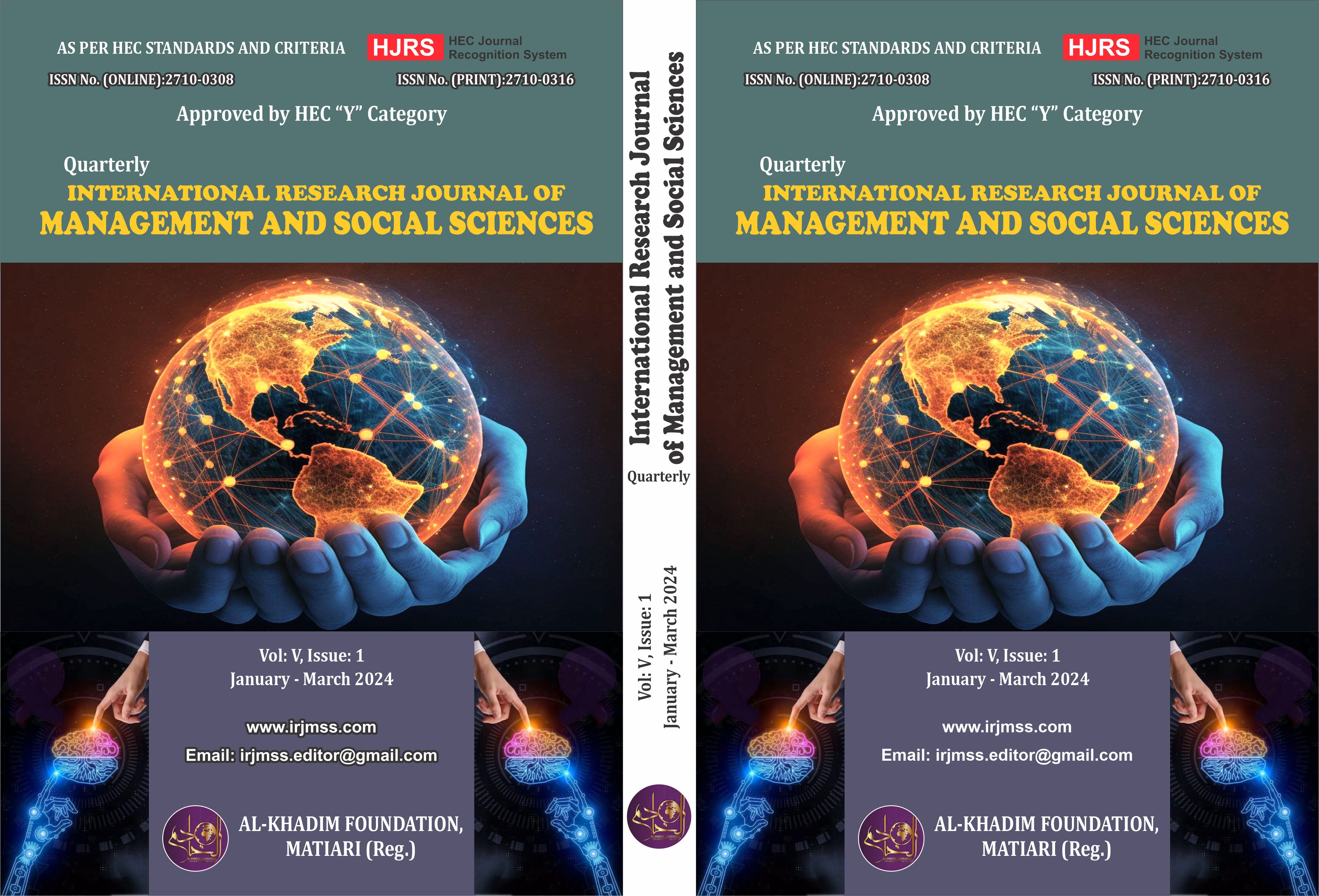Exploring the Role of Electronic Learning Pedagogical Tools in EFL Classrooms: A Case Study of the Islamia University of Bahawalpur
Keywords:
Electronic Learning, EFL, L2 Classrooms, Pedagogical ToolsAbstract
The exclusive purpose of this activity was to explore the role of electronic learning pedagogical tools in EFL classrooms while learning L2 at the Department of English Linguistics, the Islamia University of Bahawalpur. The learners’’ questionnaire was developed as a data collection tool. The BS students were the population of the above-mentioned university and the department. The collected data of 209 learners was analysed through the SPSS. The results of the current study showed that the study's participants had the most positive opinions toward the use of electronic learning pedagogical aids in EFL classes. The study themes and current theories of online learning were taken into consideration when analysing the data. Additionally, by employing electronic learning pedagogical tools to reduce the barriers of the electronic learning environment, learning proficiency learners might be able to improve their language learning outcomes. The study concludes that before implementing any electronic learning pedagogical tools, professionals should take into account the needs of EFL students, the curriculum, and the technological proficiency of teaching staff.
References
Andersson, A. (2008). Seven major challenges for e-learning in developing countries: Case study eBIT, Sri Lanka. International journal of education and development using ICT, 4(3), 45-62.
Andersson, A., & Grönlund, Å. (2009). A conceptual framework for e‐ learning in developing countries: A critical review of research challenges. The electronic Journal of information systems in developing Countries, 38(1), 1-16.
Bilotserkovets, M. A., & Gubina, O. Y. (2019). Target language teaching by means of e-
learning: a case study.
Coryell, J. E., & Chlup, D. T. (2007). Implementing e-learning components with adult
English language learners: Vital factors and lessons learned. Computer Assisted
Language learning, 20(3), 263-278.
Górska, D. (2016). E-learning in Higher Education. The Person and the Challenges. The
Journal of Theology, Education, Canon Law and Social Studies Inspired by Pope John Paul II, 6(2), 35-43.
Gutiérrez-Santiuste, E., Gallego-Arrufat, M. J., & Simone, A. (2016). Barriers in computer- mediated communication: typology and evolution over time. Journal of e-learning and Knowledge Society, 12(1).
Habul-Šabanović, I. (2016). Foreign language learning anxiety in an EFL context. Journal of Foreign Language Teaching and Applied Linguistics, 71.
Huang, P., & Hwang, Y. (2013). An exploration of EFL learners' anxiety and e-learning environments. Journal of Language Teaching and Research, 4(1), 27.
Japar, M., Fadhillah, D. N., & Syarifa, S. (2019). Civic Education through E-Learning in higher education. Advances in Social Science, Education and Humanities Research, 335, 505-511.
Kanuka, H. (2006). Instructional Design and eLearning: A Discussion of Pedagogical
Content Knowledge as a Missing Construct. E-Journal of Instructional Science and Technology, 9(2), n2.
Keengwe, J. (2005). Enhacing e-learning through Technology and constructivist pedagogy. In E-Learn: World Conference on E-Learning in Corporate, Government, Healthcare, and Higher Education (pp. 1357-1361). Association for the Advancement of Computing in Education (AACE).
MacDonald, C. J., & Thompson, T. L. (2005). Structure, content, delivery, service, and outcomes: Quality e-learning in higher education. International Review of Research in Open and Distributed Learning, 6(2), 1-25.
Naresh, B., & Reddy, B. S. (2015). Challenges and opportunity of E-learning in developed and developing countries-a review. International Journal of Emerging Research in Management &Technology, 4(6), 259-262.
Nartiningrum, N., & Nugroho, A. (2020). OnlinE-learning amidst global pandemic: EFL students’ challenges, suggestions, and needed materials. ENGLISH FRANCA: Academic Journal of English Language and Education, 4(2), 115-140.
Nguyen, Q. L. H. T. T., Nguyen, P. T., Huynh, V. D. B., & Nguyen, L. T. (2020). Application Chang's extent analysis method for ranking barriers in the e-learning model based on multi-stakeholder decision making. Universal Journal of Educational Research, 8(5), 1759-1766.
Nugroho, A. D. (2020). How E-Learning Deals with Higher Education during the Pandemic in Indonesia. Loquen: English Studies Journal, 13(2), 51-59.
Nugroho, A., & Mutiaraningrum, I. (2020). EFL teachers’ beliefs and practices about digital learning of English. EduLite: Journal of English Education, Literature and Culture, 5(2), 304-321.
Pituch, K. A., & Lee, Y. K. (2006). The influence of system characteristics on e-learning use. Computers & Education, 47(2), 222-244.
Poongodi, A., & Periasamy, J. K. (2020). Enhancing English Speaking Skills of Engineering Students in Virtual Classroom. International Journal, 8(10).
Qureshi, I. A., Ilyas, K., Yasmin, R., & Whitty, M. (2012). Challenges of implementing e- learning in a Pakistani university. Knowledge Management & E-Learning: An International Journal, 4(3), 310-324.
Saadé, R. G., & Kira, D. (2009). Computer anxiety in e-learning: The effect of computer self- efficacy. Journal of Information Technology Education: Research, 8(1), 177-191.
Shahi, M. J. (2016). The impact of e-learning on improving Iranian EFL learners’ language
skills: decreasing learning anxiety. Journal of Fundamental and Applied Sciences, 8(3), 261-275.
Shea, C. O., Lillis, D., Shea, S. O., & Collins, P. (2005, June). The application of e-learning and m-learning technology in the context of Life Long Learning in Irish Higher Education. In EdMedia+ InnovatE-learning (pp. 568-572). Association for the Advancement of Computing in Education (AACE).
Saleem, M. A., & Rasheed, I. (2014). Use of E-learning and its Effect on students. New
Media and Mass Communication, 26, 47-51.
Shea, C. O., Lillis, D., Shea, S. O., & Collins, P. (2005). The application of e-learning and m-learning technology in the context of Life Long Learning in Irish Higher Education. In EdMedia+ InnovatE-learning (pp. 568-572). Association for the Advancement of Computing in Education (AACE).
Simuth, J., & Sarmany-Schuller, I. (2012). Principles for e-pedagogy. Procedia-Social and
Behavioral Sciences, 46, 4454-4456.
Strong, R., Irby, T. L., Wynn, J. T., & McClure, M. M. (2012). Investigating Students'
Satisfaction with eLearning Courses: The Effect of Learning Environment and Social
Presence. Journal of Agricultural Education, 53(3).
Tanveer, M. (2011). Integrating e-learning in classroom-based language teaching: Perceptions, challenges and strategies. In International Conference “ICT for
Language learning” (pp. 23-28).
Tsabedze, V., & Ngoepe, M. (2020). A framework for archives and records management education in an open distance e-learning environment in eSwatini. Education for Information, 36(2), 157-175.






